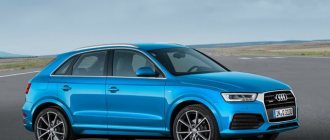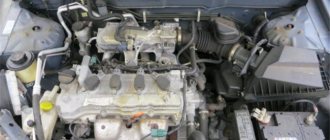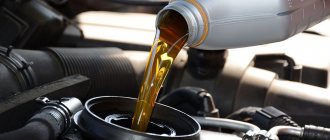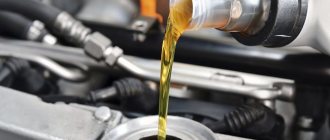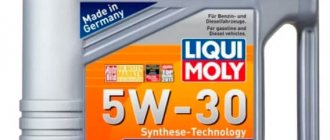Trouble struck one of the owners at 135,000 km. During a normal drive, the check engine light came on and the engine went into limp mode. An oil check showed that the level had dropped below the minimum level. And this despite the fact that the oil was added 250 km ago and the level was normal.
The car went to a service center, where it was diagnosed as engine wear. But how is it possible - only 135,00 km and the diesel engine has arrived? Interestingly, the roadside assistance worker who was called to the scene of the incident (it happened in Germany) was not at all surprised. He said that in the case of the Transporter equipped with the 2.0 TDI CFCA, what happened was business as usual.
135,000 km is still not a bad result, since many T5 diesels ran out of power even at the interval of 60-90 thousand km.
The 2.0 TDI twin-supercharged engine is coded CFCA and develops 180 hp. and is a derivative of the “old” 2.0 TDI EA 189 series (the same one that was involved in the emissions fraud story). CFCA was installed in the Transporter in 2009-2015. In the fall of 2015, it gave way to a completely new diesel engine from the EA288 family.
Notably, the twin-supercharged variant was used in the Volkswagen Crafter and Amarok. It developed 163 hp. and was designated by the code CKUB. But it is the CFCA that should be avoided.
Of the approximately 140,000 engines produced, about 11,800 engines seized after relatively little mileage. In Germany alone, 6,300 such cases are mentioned.
It is worth noting the scandal in Norway. The medical service purchased 166 ambulances based on the Volkswagen T5 with 2.0 TDI / 180 hp. Soon, 150 cars were out of order due to engine problems. Coincidence? Don't think!
It all starts with oil...
The first typical sign that the end is approaching is a significant increase in oil consumption. But the immediate cause of the malfunction is a defect in the EGR valve cooler.
BMW also had a problem with the USR. True, in his case the consequences are much more dangerous. There was a real risk of spontaneous combustion, which is what a number of Bavarian owners faced. In VW, the malfunction only threatened to jam the engine.
In the 2.0 TDI CFCA, it all starts with corrosion from an incorrectly designed EGR valve cooler. The aluminum from which the radiator fins are made oxidizes and crumbles, and the fragments enter the cylinders through the exhaust gas recirculation system. The garbage begins to wreak havoc, the first symptom of which is an increase in oil consumption to 1-1.5 liters per 1000 km.
The exhaust gas recirculation cooler is integrated into the oil filter module.
The aluminum particles act like sandpaper. Sawdust damages cylinder walls, pistons and rings. At some point, the axial clearance on the ring becomes so large that the ring becomes something like a pump forcing oil into the cylinder.
Repair? Possible, but usually very expensive. Owners often decide to completely replace the engine.
Advice for all CFCA owners: if the engine does not consume oil yet, then replace the EGR module with a modernized one (designation “D”) as soon as possible. When the engine starts eating oil, it will be too late.
Volkswagen only acknowledged and disclosed the cause of the defect in 2015 – more than five years after the debut of the 2.0 TDI CFCA. Volkswagen dealerships have received TPI instruction No. 2039830. It reports the problem of increased oil consumption in CFCA engines and indicates what steps should be taken: measuring oil consumption, replacing the engine, DPF filter (when the engine consumes a large amount of oil, there will soon be nothing left of it), catalyst and lambda probes ( oxygen sensors). The powerful operation is estimated at several hundred thousand rubles.
Do you think Volkswagen bears all the costs? Whatever the case! There are cases where VAG paid for part of the repairs, but the car had to have a documented history in the dealer network. And this is despite the fact that the malfunction is the result of a design miscalculation, and not a violation of operating conditions.
One owner had to update the engine three times - every 80,000 km. However, the service covered only half the cost. For another, they initially agreed to pay 50% of the costs, but then the compensation was reduced to 30%. Why? Because the oil consumption measurement was carried out on an engine already operating in emergency mode, and the lubricant consumption turned out to be low!
What oil should be used for the Volkswagen Transporter engine
Original
For a new Volkswagen Transporter that is under warranty, it is always recommended to use a branded lubricant with VW approvals 502/505 or 504/507. As for viscosity, it is selected depending on temperature conditions. So, SAE 0W-40, 0w-30 or 5W-30 is suitable for winter use, and in summer you can choose 20w-40 or 25W-50. If the car is used all year round, then it should be filled with all-season oil with parameters 10W-40, 10W-30 or 5W-40.
Also read: Engine oil for Opel Omega engine
Unoriginal
Among the good analogue motor oils for the Volkswagen Transporter are the proven brands Kixx, Valvoline, Liqui Moly, Castrol, Motul, Shell, etc. In any case, a relatively inexpensive analogue is more suitable for used cars with high mileage that are not under warranty. In addition to the appropriate brand, when choosing an analogue oil, you also need to know about the characteristics of the product. For example, API approval is important, which is selected based on the model year of the vehicle and the type of internal combustion engine.
For example, for a gasoline T4 1990. An all-season “mineral water” with parameters SAE 15W-30 and API-SG is suitable. For diesel engines - API-CD-II or CE. For newer gasoline cars released in 2003, a 5W-20 mineral all-season oil with API-SJ approval is recommended. For diesel engines - API-CF, CG or CG-4. As for the fifth generation Transporter, released in 2004, owners of such cars can be advised to use all-season semi-synthetic SAE 10W-30 with API-SJ approval.
For diesel engines – CG-4 and CH-4. For more recent diesel cars, released in 2009, API-CI is suitable, and for gasoline cars - semi-synthetic API-SL. And finally, the sixth generation VW Transporter with a gasoline engine will require all-season synthetic oil with SAE 10W-40 viscosity and API-SM approval. As for 2021 cars, pure synthetic API-SN is recommended for them. For diesel engines - API-CJ-4. Below are the best analogue engine oils for the Volkswagen Transporter using the T5 generation as an example.
According to approval 504/507:
- Mobil ESP Formula 5-30 art 152621
- Shell Helix HX8 ECT 5W-30 art 550048035
- Castrol Edge Titanium 5W-30 art 15669A
- Motul Specific 504/507 5W-30 art 106375
According to approval 502/505:
- Liqui Moly Top Tec 4100 5W-40 art 3701 or 7501
- Mobil Super 3000 X1 SAE 5W-40 art 152061
- Motul 8100 XClean FE 5W-30 art 104777
- Castrol EDGE C3 5W-30 art 15A5658.
Volkswagen's position
Increased oil consumption only occurs under certain conditions and depends on driving style. However, 140,000 vehicles have undergone a preventative replacement of the EGR module.
If you detect increased oil consumption, you should contact an official VW service center, where they will perform an accurate measurement. What you do next depends on how much lubricant the engine actually consumes. Each case is considered separately, and if certain conditions are met, Volkswagen is ready to bear part of the costs.
The problem only affects the 2.0 TDI twin-supercharged version equipped with an aluminum EGR valve cooler. The malfunction does not occur in other engine versions.
Volkswagen Transporter engine - how much oil to fill
Fourth generation 1990-2003 T4
The T4 model became the first “Transporter” with a front engine and front-wheel drive. Later, all-wheel drive became available. The car received two wheelbase options - short and long.
In addition, it was possible to choose the height of the roof. The car had a compact rear suspension with coil springs above the rear arms - this solution ensured optimal load on the floor when loaded. T4 was produced in the following versions: Panel Van (van with solid sides), Kombi Van/Half Panel (van with a window in the central side section), Caravelle/Multivan (bus with panoramic glazing), Sestfalia (mini-camper), DoKa (flatbed cargo platform) with a double five-seater cabin) and Pritschenwagen (a flatbed cargo platform with a short three-seater cabin).
Also read: Engine oil for Chery Tiggo 7 engine
Gasoline engines 1990-2003
- 2.0 AAS, oil volume - 5 liters, tolerance and viscosity: tolerance and viscosity: API-SG, SH, SJ; SAE 10W-40, 10W-30, 0W-40, 0W-30, 5W-40
- 2.5 (AAF, ACU, AEN, AEU), oil volume - 4.5 liters, tolerance and viscosity: API-SG, SH, SJ; SAE 10W-40, 10W-30, 0W-40, 0W-30, 5W-40
Diesel engines 1990-2003
- 1.9 TD (ABL), oil volume - 4.3 liters, tolerance and viscosity: API-CD-II, CE, CF-4, CG, CG-4; SAE 5W-40, 0W-30, 0W-40, 10W-40, 10W-30
- 2.4 D (AAB), oil volume - 4.5 liters, tolerance and viscosity: API-CD-II, CE, CF-4, CG, CG-4; SAE 5W-40, 0W-30, 0W-40, 10W-40, 10W-30
- 2.5 TDI (AJT, AYY), oil volume - 5.5 liters, tolerance and viscosity: API-CD-II, CE, CF-4, CG, CG-4; SAE 5W-40, 0W-30, 0W-40, 10W-40, 10W-30
Fifth generation 2003-2015 T5
The fifth generation of Transporter saw significant changes in exterior and interior design. However, this car is based on the modernized design of its predecessor - it has the same front-wheel drive layout and transverse engine arrangement. In this case, the transmission lever is moved to the front panel. In the most expensive versions (Multivan, Caravelle, California), the car stood out with chrome side stripes on the body. Technical innovations include updated diesel engines with pump injectors, turbocharging and direct injection. The transporter, equipped with 5- or 6-cylinder engines, was available with all-wheel drive and automatic transmission. The car was produced in Germany, Poland and Russia.
The T5 model was the first Transporter that was never officially delivered to the United States. Perhaps this was due to the remaining copies of T4, which were subsequently sold out very quickly. Since then, the VW Routan has been considered an analogue of the Transporter in the American market. In Europe, the most expensive T5 was the Multivan Business modification costing 120 thousand euros.
This car was equipped with bi-xenon headlights, a navigator, climate control, automatic sliding doors, a refrigerator, a table in the center of the cabin, entertainment systems, etc. In 2007, sales of a modification with an extended wheelbase of 5290 mm began. In 2010, an updated version was released with a revised design and new turbo engines. For the first time, twin-supercharged (bi-turbo) engines became available.
Gasoline engines 2009-2015
- 2.0 115 l. With. (AXA), oil volume - 5 liters, tolerance and viscosity: API-SJ, SH, SL; SAE 5W-40, 0W-40, 0W-30, 10W-40, 10W-30
- 2.0 150 l. With. (CJKB), oil volume - 5.7 liters, tolerance and viscosity: API-SJ, SH, SL; SAE 5W-40, 0W-40, 0W-30, 10W-40, 10W-30
- 2.0 204 l. With. (CJKA), oil volume - 5.2 liters, tolerance and viscosity: API-SJ, SH, SL; SAE 5W-40, 0W-40, 0W-30, 10W-40, 10W-30
Also read: Motor oil for Mercedes-Benz W221 engine
Diesel engines 2009-2015
- 2.0 102 l. With. (CAAB), oil volume - 7.4 liters, tolerance and viscosity: API-CG-4, CH, CH-4, CI; SAE 5W-40, 10W-40, 10W-30, 0W-30, 0W-40
- 2.0 140 l. With. (CCHA, CAAC), oil volume - 7 liters, tolerance and viscosity: API-CG-4, CH, CH-4, CI; SAE 5W-40, 10W-40, 10W-30, 0W-30, 0W-40
- 2.0 180 l. With. (CFCA), oil volume - 7 liters, tolerance and viscosity: API-CG-4, CH, CH-4, CI; SAE 5W-40, 10W-40, 10W-30, 0W-30, 0W-40
- 2.0 84 l. With. (CAAA), oil volume - 7.4 liters, tolerance and viscosity: API-CG-4, CH, CH-4, CI; SAE 5W-40, 10W-40, 10W-30, 0W-30, 0W-40
Sixth generation from 2015 T6
The 2015 VW Transporter has a similar body shape to its predecessor. The only differences are in the design of the front and rear lights, as well as the design of the radiator grille. Much more changes - inside and in terms of equipment. The vehicle is available in a variety of versions: 9-seater minibus, flatbed truck (with a single or double cabin, as well as a wooden platform with a volume of 5.2 sq. m), ambulance, police, cash-in-transit vehicle with an armored body, refrigerator, etc. d. The most expensive passenger modification is traditionally considered to be a Camper with camping equipment.
Gasoline engines since 2015
- 2.0 150 l. With. (CJKB), oil volume - 5.7 liters, tolerance and viscosity - API-SM, SN; SAE 5W-40, 0W-40, 0W-30, 10W-30, 10W-40
- 2.0 204 l. With. (CJKA), oil volume - 5.2 liters, tolerance and viscosity - API-SM, SN; SAE 5W-40, 0W-40, 0W-30, 10W-30, 10W-40
Diesel engines since 2015
- 2.0 102 l. With. (CAAB), oil volume - 7.4 liters, tolerance and viscosity: API-CI-4, CJ, CJ-4; SAE 5W-40, 0W-40, 0W-30, 10W-30, 10W-40
- 2.0 140 l. With. (CCHA, CAAC), oil volume - 7 liters, tolerance and viscosity: API-CI-4, CJ, CJ-4; SAE 5W-40, 0W-40, 0W-30, 10W-30, 10W-40
- 2.0 180 l. With. (CFCA), oil volume - 7 liters, tolerance and viscosity: API-CI-4, CJ, CJ-4; SAE 5W-40, 0W-40, 0W-30, 10W-30, 10W-40

